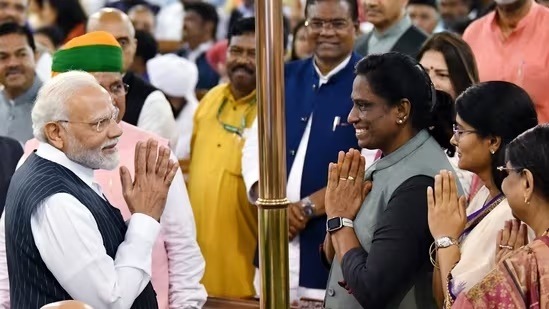In a first big move after shifting to the new Parliament building, the government on Tuesday (September 19) introduced a constitutional amendment bill named ‘Nari Shakti Vandan Adhiniyam’ to reserve one-third of seats in Lok Sabha and state assemblies for women, reviving a bill which has seen nearly three decades of stalling and discord over lack of consensus among parties.
Making it the first bill to be introduced in the new Parliament building, Prime Minister Narendra Modi said it will enable greater participation of women in policy-making at the state and national levels and help achieve the goal of making India a developed country by 2047.
“Discussion on the Women’s Reservation Bill happened for a long time. During Atal Bihari Vajpayee’s regime women’s reservation bill was introduced several times but there was not enough majority to pass the bill, and because of this, the dream remained incomplete. Today, God has given me the opportunity to take it forward,” PM Modi said in the Lok Sabha.
Also Read: Women’s Reservation Bill is ‘ours’, says Sonia Gandhi
The statement of objects and reasons says the bill seeks greater participation of women as public representatives in policy-making at the state and national levels.
If passed in both the Houses, it will be the first historic bill to be passed in the new Parliament building.
Also Read: Women’s Reservation Bill back in focus, but rollout unlikely before Lok Sabha elections 2024
Nari Shakti Vandan Adhiniyam: All you need to know
- Introducing the ‘Nari Shakti Vandan Adhiniyam’, Law minister Arjun Ram Meghwal said it aims to provide 33 per cent reservation to women in Parliament and assemblies.
- Notably, women’s reservation can only come into effect after the delimitation exercise is undertaken in India. This means that the law cannot be implemented before the 2024 Lok Sabha elections.
- As per existing law, the next delimitation exercise can only be conducted after the first Census which will be undertaken post 2026. This effectively means that the bill cannot be implemented until at least 2027.
(Article 82 of the Constitution, as amended in 2002, says the delimitation process can be carried out based on the first Census taken after 2026. Originally, the first Census after 2026 was to be carried out in 2031, which would be followed by delimitation. The Census was meant to be held last in 2021 but was delayed because of Covid, so the next count might be in 2027.)
- The women’s quota bill will be in force for 15 years after becoming an Act, but its term can be extended. Importantly, the seats reserved for women will be rotated after each delimitation exercise.
- The six-page bill says a third of seats in Lok Sabha and state assemblies will be reserved for women and filled by direct election. Also, the quota will not apply to Rajya Sabha or state Legislative Councils. This will include reserving one-third of the seats kept for SC/STs, and “as nearly as possible”, one-third of the total seats in the general category.
- The provisions of the women’s quota bill will come into effect after delimitation or redrawing of constituencies after “the relevant figures for the first Census taken after the commencement of the Constitution (One Hundred and Twenty-eighth Amendment) Act 2023 have been published” and will cease to have effect 15 years after its enactment, says the bill.
- Rotation of seats reserved for women will happen only after each subsequent delimitation exercise, to be determined by Parliament by law
- The bill is similar to the Women’s Reservation Bill drafted in 2010 when the Manmohan Singh-led Congress government was in power. Only two amendments to bring in quota for the Anglo-Indian community have been dropped in the new version.
Currently, women only make up 14 per cent of parliament and legislatures in India, which is far lower than the world average.
According to Law minister Arjun Ram Meghwal, once the bill comes into force, the number of women members in Lok Sabha will rise to 181 from the current tally of 82 women Lok Sabha members.

